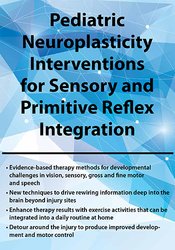

Our brains can be rewired to enhance new learning. In some cases, the brain acts as an adaptive mechanism to compensate for lost function or maximize remaining function in the event of brain injury.
As therapists, when we treat the causes and symptoms of these motor delays, we can utilize alternate brain pathways to improve the effects of therapy. Neuroplasticity treatment advances motor and cognitive functions in the brain.
This course delivers new and exciting ideas on how to detour around damage and incorporate viable nervous system connections, from congenital abnormalities to traumatic brain injuries. You’ll learn how to use therapy approaches that can change the brain in the areas of reaction timing, motor control, language, and sensory development and how neuroplasticity can positively affect challenges some children have such as poor auditory processing, hinders in reflex integration, delayed developmental milestone achievement, poor language development, and more!
In this recording, you will gain creative and evidence-based approaches to incorporate into a multisensory experience and drive home the importance of diverse and novel activities during treatment sessions. Video case studies will demonstrate changes before and after integrative neuroplasticity treatments. The therapy techniques learned in this one-day course can be easily integrated into the clinic or home as early as the next day!
| File type | File name | Number of pages | |
|---|---|---|---|
| Manual - Pediatric Neuroplasticity Interventions for Sensory and Primitive Reflex Integration (4.20 MB) | 46 Pages | Available after Purchase | |
| Large Print Manual - Pediatric Neuroplasticity Interventions (10.5 MB) | 63 Pages | Available after Purchase | |
| Instructions for ASHA credit - Self-Study Only (64.4 KB) | Available after Purchase | ||
| Large Print Manual - Pediatric Neuroplasticity Interventions - French (10.5 MB) | 63 Pages | Available after Purchase | |
| Manual - Pediatric Neuroplasticity Interventions for Sensory and Primitive Reflex Integration - French (4.20 MB) | 46 Pages | Available after Purchase | |
| Large Print Manual - Pediatric Neuroplasticity Interventions - Italian (10.5 MB) | 63 Pages | Available after Purchase | |
| Manual - Pediatric Neuroplasticity Interventions for Sensory and Primitive Reflex Integration - Italian (4.20 MB) | 46 Pages | Available after Purchase |

April Christopherson, OTR/L, has been an occupational therapist for over 25 years and has worked with diverse populations in a variety of settings. She is the founder and owner of Exploration Kids Therapy in Colorado. April worked as the director of OT and director of training and development for over 10 years for The Shandy Clinic in Colorado Springs, CO. She sits on the clinical advisory board for Interactive Metronome Corporation. She is a member of both the Advanced Brain Technologies and Interactive Metronome adjunct faculty where she teaches introductory and advanced continuing education courses to professionals. She has traveled around the USA and the world teaching on Neuroplasticity and Development. April was granted her degrees in Occupational Therapy and Psychology from St Ambrose University in Davenport, IA in 1991.
Speaker Disclosures:
Financial: April Christopherson maintains a private practice and is the owner of Exploration Kids Therapy. She is an instructor, consultant and author with Advanced Brain Technologies and Interactive Metronome. She receives compensation as a public speaker and consultant. April Christopherson receives a speaking honorarium and recording royalties from PESI, Inc. All relevant financial relationships with ineligible organizations have been mitigated.
Non-financial: April Christopherson has no relevant non-financial relationships.
Please wait ...